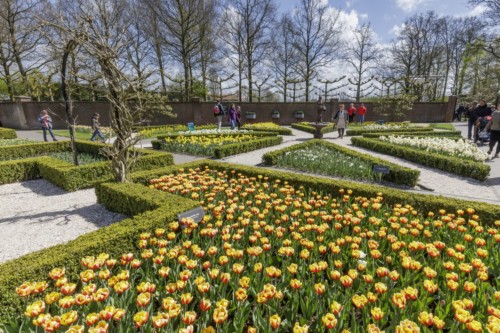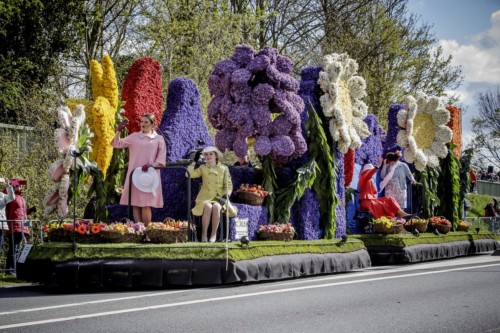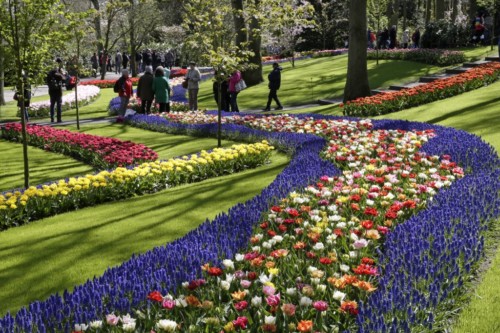This Spring, Tiptoe Through the Tulips at Keukenhof in Holland
One of the world’s most famous spring gardens, Keukenhof, is a garden of over seven million tulips, hyacinths and daffodils, ablaze with pink, red, purple, yellow, lavender and orange from late March to late May. By the numbers, it’s the biggest spring attractions in Holland: over one million people visited last year, and in recent years an increasing number of these patrons have been Americans.
Near Amsterdam, this 17-acre park in the town of Lisse is an unforgettable spot to stroll. Bring the family: besides fields of vivid color as far as the eye can see, there’s a windmill, lake, adorable petting zoo of lambs and baby goats, playground and treasure hunts focused on nature.
An exhibit on “Tulip Mania” explains the fascinating history of the tulip as an object of desire, from 1634-47 in Holland, when tulip fanatics bid insane prices for bulbs (the original stock market bubble), the story of the black tulip (the Dutch tried for centuries to grow it in a grail-like quest, and it became a myth; in 1986, a Dutchman finally succeeded) and famous people the flowers were named after in the Juliana Pavilion.
Every year, there’s a theme. In 2017, it’s “Dutch Design”, as Dutch architects, artists, fashion and furniture designers from Rem Koolhaas to Piet Mondriaan are known for simplicity and innovation. Some highlights: a huge mosaic garden of 80,000 tulips, crocus and grape hyacincths, arranged in Mondriaan squares of primary colors (over 2,600 square feet in size), and Dutch Design Week, which offers exhibits, talks, and workshops by designers and architects.
It’s one of many events at Keukenhof during the blooming season, ranging from a Food & Flowers Festival (showing how flowers enhance food and drink, with tastes for sale), classical music and band concerts, and the Flower Parade.
The Flower Parade, which features floats of whimsical creatures created from flowers and costumed paraders which lend a Mardi Gras touch, follows a 25-mile route to Haarlem from Noordwiijk, passing by Keukenhof, on April 22. Last year, Keukenhof’s theme was “Amsterdam’s Golden Age”, because 2016 marked the 400th anniversary of building the Canal Ring, the UNESCO-listed treasure of concentric canals lined by townhouses for wealthy merchants. The 2016 mosaic garden portrayed Amsterdam and its ships back when it was a world trading power.
“Tulips symbolize Holland in many people’s minds. But the flowers came to Amsterdam from Turkey in 1593, and are native to the mountains of Central Asia.”
Tulips symbolize Holland in many people’s minds. But the flowers came to Amsterdam from Turkey in 1593, and are native to the mountains of Central Asia. In fact, Turkey is obsessed with tulips: tulips dominated Turkish decorative arts for centuries, and I spotted them in ceramics, textiles, carpets, jewelry to engravings on marble, wood and even swords on my visit. (Even today, a stylized tulip is in the logo of Tourism Turkey and painted on Turkish Airlines airplanes.)
Turkey had a “Tulip Era” in the 18th century, when the arts were highly prized by the Ottoman court, and also a “Tulip Rebellion.” During this riot in 1730, Istanbul mobs, enraged that the Sultan spent so much money on growing tulips at Topkapi Palace and not on public services, stormed the palace, forced him to abdicate, and burned tulip gardens all over the city. But don’t worry: tulips by the millions are planted for Istanbul’s International Tulip Festival each April. (In Amsterdam, visit the Tulip Museum to learn intriguing facts about tulip history and the plant’s cultivation.)
Getting there: Take a tour to/from Keukenenfhof from Amsterdam through the local tourist office. Or, take a train from Amsterdam’s Central Station to Schiphol Airport (a 15-minute ride), then a Keukenfof Express Bus (a 20-30 minute bus ride). On arrival, guided garden tours, bike rentals, and boat tours are available.
Keukenenfhof’s Tulips are on display from March 23rd to May 25, 2017. Tickets are available for purchase here.






































